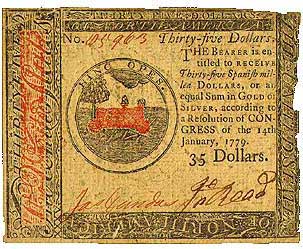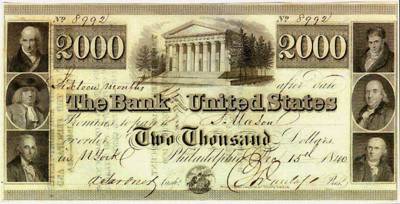Sunday, January 09, 2005
The American Currency Exhibit and the Jackson Five
Here is the obverse of currency of the New Jersey colony, 1776, "the fourteenth year of the reign of His Majesty King George the Third."


And the reverse, which declares that "'tis death to counterfeit." The next time you hear the argument that the Eighth Amendment of the Constitution prohibits capital punishment as "cruel and unusual," consider the prevailing penalties for financial crimes in the 18th century!


The Continental Congress issued $35 bills in 1779. Too bad we don't have them today -- I often find myself in need of a denomination half way between the $20 and the $50.


Here's the reverse:


With the Second Bank of the United States, a $2000 bank note:


And, of course, there are many examples of the less-than-sound currency from the Confederate States of America.


And, finally, the very first "Jackson Five"!


Money can be beautiful.
UPDATE: Sluggo points us toward the means to calculate the value of these amounts in current dollars. It's pretty cool. I mean, if you like that kind of thing. Which I do.
1 Comments:
By Sluggo, at Sun Jan 09, 10:13:00 PM:
35 simoleans in 1779 would be a not inconsiderable sum today. Not worth $1000, maybe, but way more than $100. Got to be a commercial bill.
Ah, here it is. Several ways of figuring it.
http://eh.net/hmit/compare/result.php?use%5B%5D=DOLLAR&use%5B%5D=GDPDEFLATION&use%5B%5D=UNSKILLED&use%5B%5D=GDPCP&use%5B%5D=NOMINALGDP&amount2=&year2=&year_result=2003&amount=35&year_source=1789
Not considering the numismatical value, of course.


